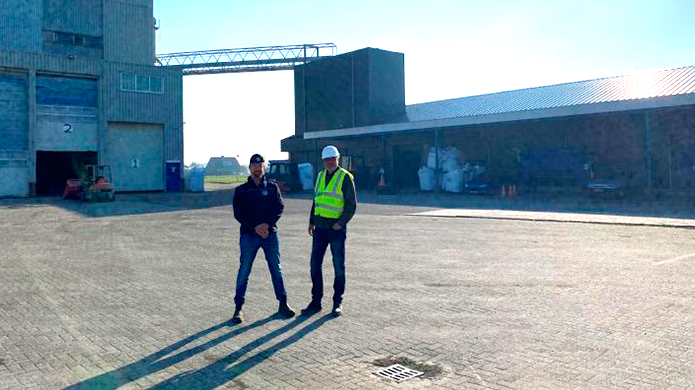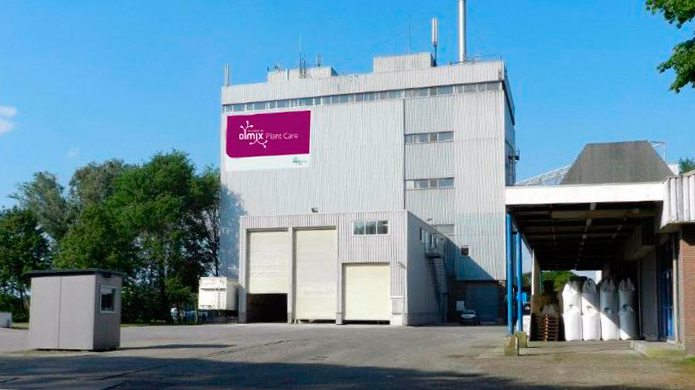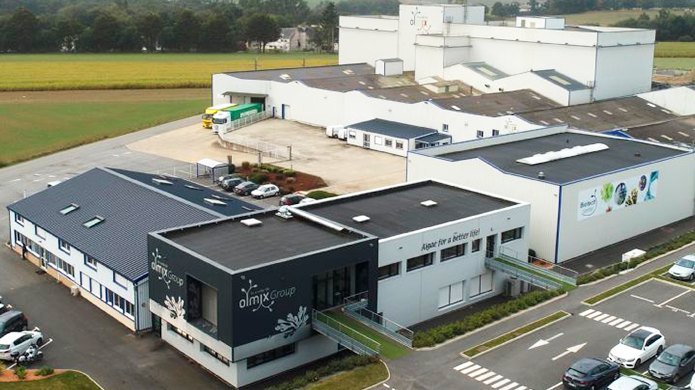Since its foundation in 1995, Olmix Group has successfully developed a complete marine algae processing chain, which involves collecting algae from the coast, a biorefinery process for valorizing their extraordinary properties, and developing natural algae-based products for plants and animals organised in programs for an agriculture with less chemical intrants and antibiotics. From the will to propose healthy products to the final consumers, the company has managed to spread its know-how and vision from the region of Brittany in France to more than 100 countries all around the globe. This international expansion led Olmix to acquire a new factory in the area of Rogat (Drenthe, the Netherlands) in 2016, where the company is currently producing some of their organic-mineral fertilizers such as the well-known Marathon range.
Jaap de Vries, Manager of Operations, and Geert Bakker, Regional Sports & Amenity Turf Sales Manager, talk about the history of these production facilities as well as the Olmix Plant Care local projects in a recent interview with Greenkeeper magazine.
"This factory has quite a particular history. Back in 2001 a group of chicken farmers, united under the business name of Sunny Egg Systems, took over the factory with the business purpose of converting chicken manure into fertiliser pellets. After that, in 2008 a new facility was built next to the main one to add fertiliser to these manure pellets. These pellets brought the interest of Olmix Group and in 2016 the company decided to buy the whole site as they wanted to have full control of the production process. Not only was the entire intake revamped, but the rest of the factory was also fully refurbished. Initially, Olmix continued to process chicken manure but in 2019 the focus shifted to the production of organic-mineral fertilisers," says De Vries.
One of the most innovative changes introduced by Olmix at that time was the construction of a new grinding-mixing line in 2018, which allowed to dose up to 17 raw materials, produce more uniform products and internalise production.

Jaap de Vries and Geert Bakker.
"If previously it was only viable to produce chicken manure by adding just a grain of fertiliser, now we are able to dose up to 17 different raw materials and reduce them to a powder of 1.5 mm. From that we now manage to make a nice and uniform pellet. I would say this is the unique thing about this factory. When I started working for Olmix in 2018, our Marathon Sport product consisted of a kind of crumbs; it was a very irregular product that we had to produce externally. With the introduction of the grinding-mixing line, there was this great opportunity to internalise production. For us, it was very important from the start to make high-quality organic-mineral fertilisers with unique techniques. That was also possible by adding value from the Olmix portfolio, such as algae, biostimulants and mineral enhancers. Our most important goal, however, was to achieve an easily spreadable granule."
According to De Vries, the uniformity of the grain overpasses some other key factors in production such as a good technique or a good ratio. In fact, uniformity is vital for greenkeepers to spread according to plan. With Olmix’s ability to dose up to 17 different ingredients, this uniformity is ensured: as all grains contain the same nutrients and content, end users can spread their organic-mineral fertilisers with exact control.
"Olmix actually uses more than those 17 raw materials. This is important because not every silo is dedicated to one raw material. The 17 raw materials can be made up of 170 different materials, so to speak. Our principle is simple: we are not biological, not ecological, but we are logical! That means that we first look at what the fertiliser is intended for: is it for the soil or is it for the plant? Depending on that, you then choose the raw materials. For example, a fertiliser for the soil needs another C/N ratio than a fertiliser for the plant. If the fertiliser is for the plant, you have to look at the purpose for which the plant is grown. After all, grass for a golf course has a completely different function than grass for a cattle farmer. We use this information to design the fertiliser. During this process, we investigate which raw materials from organic or renewable sources are available and put them to use. The plant's shortage is eliminated with the addition of fertiliser. However, we are constantly looking for a substitute from organic or renewable sources. This is our logical approach."

Olmix's factory in Rogat (the Netherlands).
Greenkeepers’ wish list
Olmix’s working method goes in hand with the "greenkeepers’ wish list". Some of the most common goals of greenkeepers are getting a beautiful dark green grass, avoiding fungus and drought or wetness stress, having roots that recover quickly, reducing spreading or mow periodicity… But also using fertiliser pellets that rapidly disintegrate and dissolve in the soil. To meet these particular needs, Olmix has released a specific fertiliser.
"At Olmix we have come up with a specific fertiliser that releases its nitrogen over a period of 10 to 12 weeks, depending on temperature and moisture. Nevertheless, if I gave the same fertiliser to a farmer, I would be wrong. A farmer wants sugars, protein, length and mass in the silage, as opposed to the greenkeepers, who prefer the plant to grow out by applying fertilisers rather than the grass growing in length. Generally speaking, greenkeepers demand a beautiful and a strong turf," says Geert Bakker.
In this context, De Vries lists a number of raw materials, such as chicken manure, sunflower seed meal, grape core meal, artificial fertilisers such as urea, potassium, phosphate, ammonium, calcium carbonate and sulphite. "We can make all kinds of recipes, such as a pre-seeder for sowing the turf, or a type that you can use all throughout spring and summer, or one with a high calcium content for the autumn, or even a grain only for the summer. That means that we can use a wide range of raw materials for different applications within our product line. Nowadays, the demand from other market parties is increasing and we also supply various retail chains through distributors. The market for organic-mineral raw materials is growing due to the reduction of artificial fertilisers and the search for a circular agriculture and horticulture.
Odour: another critical issue
Olmix is obviously also responding to this important issue for end users, especially in golf and sport grounds. Bakker: "Although you will not find a replacement for a high nitrogen source such as urea very quickly, more and more alternatives to artificial fertiliser are emerging nowadays. For example, we have some technologies being developed that can extract ammonium sulphate, which is currently still produced in a factory, from the drainage water of air scrubbers. The percentage of nitrogen in this water is too low for our products but this new future extraction method will make it possible to produce powder that can be used in our factory. The same goes for another important raw material for us, diammon phosphate (DAP 18-46). DAP could be replaced by struvite, a substance left over from water purification, but not all struvite will be used at Olmix. I must say that we are very critical with the source of the struvite, which for us must be plant-based. Also, the processability in the plant and the availability of the minerals to the plant are also of utmost important to us. But if there’s anything we always put ahead, that is our customers. We have to be very critical of the fragrance of our raw materials, because our end users in golf, sport and retail consider this very important for their business."
It is expected that the new EC 2019/2009 regulation, which comes into force this year, will be an important incentive to use renewable raw materials Europe-wide as a substitute for fertiliser.
Successful developments
The factory in Rogat is already carrying out careful trials with the available alternative materials. Bakker: "Our aim is to reduce the use of pesticides, chemical crop protection agents and artificial fertilisers. But at the same time we also seek an optimally functioning product for our users. So, we have to find a balance in this. That is why we call our approach ‘logical’, as we are well aware of the high growth rate of organic-mineral fertilisers at present. But you can’t just make such a big change overnight. If we were to do everything organically or ecologically now, it would be at the expense of the user’s yield. Moreover, we have to think that this has to be commercially interesting for both Olmix and the end user."
Some of these developments have brought excellent results to the local market in the Netherlands:

Olmix Group headquerters (Bréhan, France).
De Vries: "We are Olmix BV, a subsidiary of the Olmix Group in France. This means we can make use of the Olmix Group's extensive portfolio of unique patented techniques. We also look for synergies in purchasing and sales where it is useful and meaningful. In addition, there is a part that we have to do locally, simply because it is more practical. Of course, we do everything together, but the purchase of some raw materials, for example, has to be done locally. On the other hand, we are looking at certain raw materials for which we can set up framework contracts between the production locations in France, Germany and the Netherlands, which we then call on locally. Especially raw materials such as chicken manure but also alternatives to artificial fertiliser have to be purchased locally, because it is just natural to do so in terms of business."
Chicken manure as a source
"As in almost every sector, the current problems of price increases and raw material supply also affect the fertiliser manufacturer. However, we are in the fortunate position of having a mutual dependency with our main raw material suppliers, whereby we are each other's supplier and each other's customer. Or in other words: we are partners. This means that we hardly have any problems with our raw material supply. Although prices have risen, availability is still good. An advantage is that we are producers and not dependent on third parties for production. Actually, we have seen tremendous growth: in less than two years we have integrated organic-mineral fertilisers into our production. The continuous optimisation of our production line makes it possible to supply our customers with a good product. Moreover, we invest to be able to manufacture private label products for third parties: high quality, complex organic-mineral products, with our own technologies. We offer quality, flexibility and customisation, not to mention reliable planning and delivery."
As explained by the Operations Manager, chicken manure is the source for most products that leave the factory in Rogat. It is the carrier for the other fertilisers; about 40 to 50 percent of an organic-mineral fertiliser pellet consists of chicken manure. However, Olmix doesn’t buy this raw material at random but looks for specific qualifications, such as at least 80% dry matter, 4% nitrogen, 3% phosphate, 2.5% potassium and virtually odourless. The company buys the manure from regular poultry farmers through concrete business contracts that include specific requirements for the manure.
"We are also looking at alternatives to chicken manure, because interesting new circular flows of manure are coming onto the market. We have already done some trials with it. I cannot predict whether chicken manure alone will always be the basis, because regulations also play a role in the availability of fertilisers. We do check carefully whether an alternative fits in with our techniques and formulation of fertilisers," continues De Vries.
Algae, the core of Olmix Group
"Our main activity is to produce solutions that deliver technical and economic results for farmers, greenkeepers and field managers, in a sustainable way and in a context of climate change. We use many ingredients, including algae," explain De Vries.
The processing of algae and seaweed is one of the main activities of Olmix Group, which started in Brittany (France) in 1995. The Brittany coast is characterised by a huge contrast between low and high tide, which means that seaweed is left on the beach for a long time during low tide. Olmix has come up with a unique full biorefinery process that at a certain stage rakes up decomposed seaweed that then goes through a belt filter press at the factory in Brittany, where it is isolated into a liquid and solid fraction.
"As seaweed grows in a particular and sometimes sever climate circumstances, this liquid has several strong properties, such as growth, anti-stress and resilience. We then use the liquid as an additive for the plant. The solid fraction of seaweed, a source of organic matter, contains trace elements to stimulate and activate the soil. We apply these in our organic-mineral products, such as Marathon."



